Thompson School District: Student-Driven Learning at Work!
CompetencyWorks Blog
This post is part of an ongoing series on Colorado schools. Read about D51, DSISD, and Westminster Public Schools for more insights.
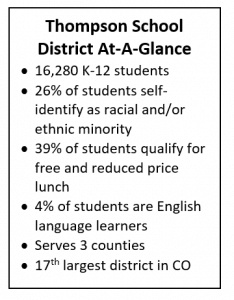 Conrad Ball Middle School sits on an unremarkable street in Loveland, Colorado. Other than its claim to fame as the nation’s “Sweetheart City,” Loveland is similar in many ways to other small- to medium-sized cities across the nation. However, across this school district, something truly different is happening inside its classrooms.
Conrad Ball Middle School sits on an unremarkable street in Loveland, Colorado. Other than its claim to fame as the nation’s “Sweetheart City,” Loveland is similar in many ways to other small- to medium-sized cities across the nation. However, across this school district, something truly different is happening inside its classrooms.
Conrad Ball Middle School (or “Con Ball” as it is referred to by district staff) is one of several schools that are leading implementation of Thompson’s vision for personalized, competency-based learning. Thompson’s vision for competency based learning is described this way.
“The teachers and staff in TSD are dedicated to working with students and families to design a personal learning pathway for each student based on their passions, strengths and needs. We care about students having more meaningful learning that is not based on seat time and gives students more choices in what they want to explore at a deeper level. Teachers are committed to providing specific feedback to help students transfer and apply the skills they gain during their learning to foster growth and inspire students to excel. We are committed to ensuring that every student is prepared for success and is college, career and community ready.”
Thompson’s competency-based structure is founded upon four core areas of teaching and learning:
1. Competency-Based Instruction is designed to:
- provide flexibility to students in demonstrating proficiency within personalized learning/personalized learning pathways,
- ensure acquisition of knowledge and skills essential for success in higher education, careers, and adult life (state standards),
- afford equitable access to education,
- support communication that helps students learn more effectively through better feedback, and
- foster ownership of the standard and the scores accessed through open gradebook.
2. Competency-Based Scoring: Students, parents, and teachers build understanding of what each scoring level looks like for each standard in each content area.
3. Competency-Based Assessment: Formative and summative assessments that are identified prior to the learning, aligned to standards, criterion referenced, and authentic to student learning.
4. Competency-Based Reporting: Consists of quarterly progress monitoring reports that are designed to be links within a year-long chain of evidence toward end-of-year expectations, and one final report card at end-of-year.
Perhaps the most noticeable thing about classes at Conrad Ball is how actively students are leading their classroom experience. Walk into Mrs. Steele’s eighth grade math class, and students are leading discussions at each of the tables scattered around the room. Student groups are re-distributed daily rather than remain fixed in static ability groups. Mrs. Steele rotates around the groups to offer guidance, answer questions and check in on progress. Meanwhile, any student can go at any time to the “Help Table” where other students sit doing their own work, but ready to be interrupted at any time to help fellow students. Outside of class, Mrs. Steele uses an online platform to review student work, provide individual feedback and make adjustments for students.
During a conversation later in the day, students explain what is different about their core classes. As one student, Jake, explains, “I like moving at my own pace in math so I don’t have to wait.” A classmate, Kyden, adds “I like going on to Mathia to find another way to solve the same problem. A lot of kids will use the way that the teacher taught them to solve a problem but now I can find another way to solve that problem.”
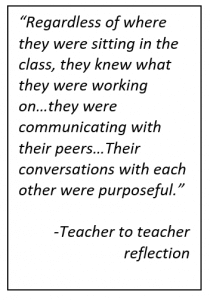 The leadership role of students is felt everywhere, not just in core classes. We walk into the school gym to find three students presenting a PowerPoint to their classmates using a portable screen and a projector sitting precariously atop a small stool. The students explain the rules of a game to their classmates, bringing out balls and other equipment to illustrate. Other students ask clarifying questions until the presenters are confident that everyone understands the rules. Then, the mixed-gender class of sixth graders jumps up and takes over the gym in a lively game that resembles a mix of dodgeball and capture the flag. Everyone is engaged and none seem to be hanging back or off to the sides. During the game, Mr. McMahon, Lifetime Sports teacher, explains that all of the students in his class are given an opportunity to lead the class. Students were given a set of parameters and then tasked with designing an activity that addressed the state Physical Education standards. Each group presented their design to their classmates, who had a chance to try each game before voting upon their favorites.
The leadership role of students is felt everywhere, not just in core classes. We walk into the school gym to find three students presenting a PowerPoint to their classmates using a portable screen and a projector sitting precariously atop a small stool. The students explain the rules of a game to their classmates, bringing out balls and other equipment to illustrate. Other students ask clarifying questions until the presenters are confident that everyone understands the rules. Then, the mixed-gender class of sixth graders jumps up and takes over the gym in a lively game that resembles a mix of dodgeball and capture the flag. Everyone is engaged and none seem to be hanging back or off to the sides. During the game, Mr. McMahon, Lifetime Sports teacher, explains that all of the students in his class are given an opportunity to lead the class. Students were given a set of parameters and then tasked with designing an activity that addressed the state Physical Education standards. Each group presented their design to their classmates, who had a chance to try each game before voting upon their favorites.
Thompson School District’s journey toward personalized learning started with the adults. Faced with the introduction of a slate of state-level policy reforms from new content standards and assessments to high school graduation guidelines aligned to college and career readiness, the district engaged teachers to reflect on a set of core questions about the experience of teaching and learning. Out of those reflections emerged a vision of competency-based, personalized learning for individual students. As Carmen Williams, Director of Assessment and Professional Development for the district, describes it, “we don’t want to have 13 one-year journeys, we want to have one 13-year journey” for each student. An interactive graphic of this vision is available online here.
Starting in the 2010-2011 school year, Thompson School District launched an intentional set of initiatives. Phase I was focused upon “Building the System of Standards-Based Instruction” and focused upon teacher understanding of the content standards and the instructional shifts that they would demand. An important early effort in this journey was the co-creation by teachers of standards-based assessments and units, including the development of common assignments that could be used to calibrate instructional practices and expectations for student work across classrooms. Launched in 2015, Phase II moved to implementing standards based instruction and preparing competencies. 2016-17 marked the final year of Phase II, an effort that culminates with schools across the district having solidified their ability to collect and assess evidence of individual student learning. Beginning with the 2017-18 school year, Thompson will shift its focus to sustaining standards-based instruction and implementation of competency-based instruction district wide.
In classrooms across Conrad Ball Middle School, the vision for personalized, competency-based learning is expressed through a variety of important design features. Three of these are described here:
- School schedule;
- Choose Your Challenge Ski Slope; and
- Plus Classes
 School Schedule: In 2014, Conrad Ball abandoned its block schedule and moved to a more traditional seven-period school day. Rather than simply revert to a traditional five-day a week dosage, core classes are offered only four days a week. This shift created space in the calendar for other courses such as Plus classes (described below) as well as opening up time for ongoing professional learning for faculty. As a result of these schedule shifts, teachers reported higher engagement with classes and students reported experiencing a “better relationship” with their teachers. Students also reported that the condensed schedule resulted in classroom experiences that felt as though teachers planned with a purpose and didn’t have as much “fluff.” Students noticed the rigor in the assignments and felt as though teachers hadn’t taught any “filler activities” with this shift. Students also appreciated having a break from a class and being able to have a breather.
School Schedule: In 2014, Conrad Ball abandoned its block schedule and moved to a more traditional seven-period school day. Rather than simply revert to a traditional five-day a week dosage, core classes are offered only four days a week. This shift created space in the calendar for other courses such as Plus classes (described below) as well as opening up time for ongoing professional learning for faculty. As a result of these schedule shifts, teachers reported higher engagement with classes and students reported experiencing a “better relationship” with their teachers. Students also reported that the condensed schedule resulted in classroom experiences that felt as though teachers planned with a purpose and didn’t have as much “fluff.” Students noticed the rigor in the assignments and felt as though teachers hadn’t taught any “filler activities” with this shift. Students also appreciated having a break from a class and being able to have a breather.
Choose Your Challenge Ski Slope: In a nod to Colorado’s mountainous landscape, Mr. Wolverton, an eighth grade Science teacher, developed the “ski slope” concept. Similar to the system used on ski slopes to indicate the degree of difficulty of each run, teachers provide a variety of entry points for students to engage with class content. Similar to the ski slope, each path allows students to enter a defined Depth of Knowledge (DOK) level towards competency in the subject area. Each student knows what the competencies are and what DOK level they are at in their journey.
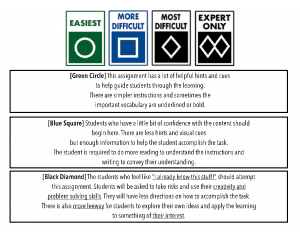
Plus Classes: The schedule shift made space for inclusion of Plus classes, as well as PLUS days for school-wide activities, including student health and wellness supports. Plus classes provide a structured opportunity for students to develop the four work habits required of all Thompson graduates: Collaboration, Communication, Creative Problem-Solving and Self-Agency. Report cards for Con Ball students reflect competencies in both the content standards and as well as these work habits. Going forward, Con Ball is developing rubrics to assist teachers in assessing competency in the work habits, as well as enable students to guide their own development in these areas.
The scheduling of Plus classes also provides valuable time for teacher content teams to collaborate on their instructional practice. Teacher teams use the time to work together on calibration of student work, review of instructional goals, as well as problems of practice identified by the team members. This focus upon teacher collaboration and leadership are consistent themes throughout Thompson School District’s implementation.
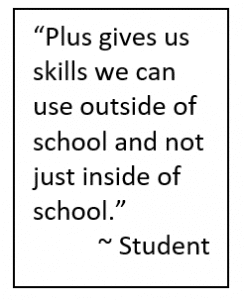 Plus classes were introduced in 2016 and to date, student response is positive. Jake, an 8th grade student describes it this way. “You should go to Con Ball because of Plus. [In Plus] you learn skills that you can use inside and also outside of school for your whole life. I thought [Plus class] wouldn’t be that important but now that I’ve gone through it I realize a lot of it is stuff you will actually use in life.” Students also reported that they appreciated the opportunity to hear from community members who present in Plus, and enjoyed the focus of community and good citizenship throughout the year.
Plus classes were introduced in 2016 and to date, student response is positive. Jake, an 8th grade student describes it this way. “You should go to Con Ball because of Plus. [In Plus] you learn skills that you can use inside and also outside of school for your whole life. I thought [Plus class] wouldn’t be that important but now that I’ve gone through it I realize a lot of it is stuff you will actually use in life.” Students also reported that they appreciated the opportunity to hear from community members who present in Plus, and enjoyed the focus of community and good citizenship throughout the year.
Walking into a Plus class one day, two students were co-teaching a lesson on humility. Classmates worked in small groups to reflect on the statement: “Humility doesn’t mean you think less of yourself. It means you think of yourself less.” The student aides led the entire class through a series of exercises, including individual self-reflection and group discussion. Throughout the class, students demonstrated tried and true instructional practices, including rephrasing of student comments and direct instruction, skills they had practiced as they developed the lesson for the day.
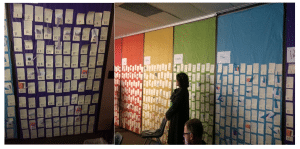
Like many other districts across the country, Thompson School District is still developing a set of explicit equity strategies to support its vision for competency-based education. The intention is there but the tools to implement are still under development. This will become increasingly important for the district as the demographics of its students and families continue to become more diverse. Despite its suburban locale, like many districts across the country, students in Thompson School District reflect the diversity of our country. Among Conrad Ball’s 600 students, 20 percent quality for special education services, 50 percent are eligible for free or reduced-price lunch, and approximately 27 percent self-identify as non-white.
There is much to take note of about Thompson School District. On the surface, much of what is happening in the school district is similar to other competency-based systems – transparent learning objectives, individualized support and personalization. However, it doesn’t take long to see that some things stand out about competency-based education in Thompson. Perhaps most importantly is the focus upon rigorous instruction. Rather than get distracted by the mechanics of competency-based education, teachers at Con Ball start with rigorous, deep learning. Everything else is a tool to support that learning. Another notable practice is the level of student leadership and agency. Students have moved beyond an individualized, differentiated course of instruction to truly understanding the teaching and learning process and holding themselves and their teachers accountable to it. Whether designing a lesson or providing critical feedback to others, students demonstrated a clear sense of personal responsibility for the learning experience. Thompson is worth paying attention to as a national leader for its work to intersect blended, project-based and personalized learning in an intentional way and to show the implications for each part of the system along a continuum that ends in competency-based, personalized learning for all.
Want to go deeper?
- Videos from Conrad Ball Middle School
- Example of graduation competencies
Nina Lopez is an independent consultant, based in Boulder, CO. Nina provides facilitation, strategy and innovation design services to private foundations, non-profit and government entities in Colorado and throughout the country to help them incubate new initiatives, develop a shared vision and a clear strategy for achieving individual and collective goals. www.ninalopez.com